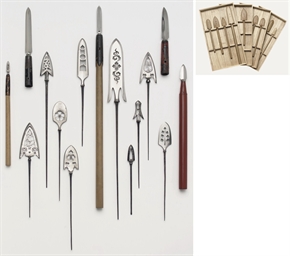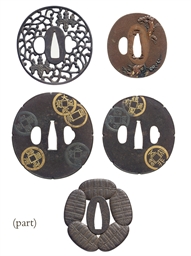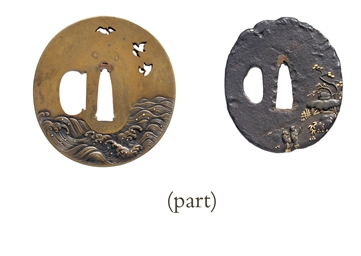An Inro Cabinet containing Twenty-Two Inro
EDO - MEIJI PERIOD (18TH - LATE 19TH CENTURY)
An Inro Cabinet containing Twenty-Two Inro Edo - Meiji Period (18th - late 19th century) The rectangular cabinet with detachable front revealing five drawers, with fitted inro compartments for twenty-two inro , decorated in iroe-hiramaki-e, takamaki-e with various depictions of tsuba and kozuka on a black ground, the drawers with a katami-gawari design in the style of Dutch leather, silver fittings; The inro : A four-case inro decorated in iroe-hiramaki-e and takamaki-e and inlaid with mother-of-pearl on a kinji ground with a peacock and peahen, signed Yoyusai saku 9cm. long Yoyusai (1772-1845/6) lived in Edo and worked on the patronage of Lord Matsudaira. A four-case inro decorated in iroe-hiramaki-e and takamaki-e on a nashiji ground with a village scene 6.5cm. high A four-case inro decorated in iroe-hiramaki-e and takamaki-e on a nashiji ground and inlaid in iroe-hirazogan and takazogan with a bamboo grove, signed Kajikawa saku 6.5cm. high A six-case inro , decorated in iroe-hiramaki-e and takamaki-e , gold foil and nashiji on a black ground with cranes in a river landscape 8.5cm. high A four-case inro , decorated in iroe-hiramaki-e and takamaki-e and gold foil on a gyobu-nashiji ground with sake drinkers and a monkey trainer 9.5cm. high A four-case inro decorated in iroe-hiramaki-e and takamaki-e and gold foil on a nashiji ground with a river landscape 9.5cm. high A two-case inro decorated in iroe-hiramaki-e and takamaki-e and gyobu-nashiji in the form of a paddle, with an attached netsuke in the form of the hat from the Cloak of Invisibility signed Toyo 11cm. high The inro is decorated in Tosa style with scenes from Heian Period court life between gold clouds in relief to represent the embossed paper so often used in this style of lacquering. A sleeve inro , the outer case decorated in gold hiramaki-e, takamaki-e and gold foil on a fundame ground, the four-case inro depicting a peacock and peahen 10.5cm. high A four-case inro decorated in black and gold hiramaki-e and gold foil on a nashiji ground with cherry blossom above a bridge, signed Kajikawa saku 9.5cm. high An inro with silver ring himotoshi and slide opening to reveal a compartment containing five drawers, decorated in gold and silver hiramaki-e and takamaki-e on a nashiji ground with insects above irises and the Eight Plank Bridge 6.8cm. high The inro depicts one of the most popular episodes in the 10th century classic of literature, the Ise Monogatari , that known as "The Tale of Yatsuhashi" [literally Eight Bridges] A four-case inro decorated in iroe hiramaki-e and takamaki-e on a kinji ground and togidashi-e on a black ground, with Rosei's Dream 8.5cm. high This design, a favourite subject in later Edo period inro , is based on a tale that can be traced back as far as Tang dynasty China and has probably been known in Japan since the 15th century, when a version was written for the Noh theatre. The story goes that a struggling scholar called Rosei (in Chinese, Lu Sheng) complained to a Daoist hermit about his poverty. The hermit pulled a pillow out of his bag and told Rosei that if he slept on it he could become as prosperous as he wanted. Rosei followed the hermit's instructions when he next stopped at an inn and promptly had a dream where he enjoyed wealth, women and success, rising to become a senior minister for ten years and eventually dying at a ripe old age. When Rosei woke up he found that the millet that was being cooked for him was not yet ready, because he had only been asleep for a few moments. A four-case inro , decorated in iroe hiramaki-e, takamaki-e and gold foil on a kinji ground with a hawk in snowy pine, signed Jokasai 8.5cm. high A four-case inro decorated in iroe hiramaki-e and takamaki-e on a nashiji ground with Hotei and various revellers in a boat, signed Kajikawa Saku , and an attached wood netsuke of Ebisu signed Shuzan The inro 7.2cm. high, the netsuke 5cm. high A three-case inro decorated in iroe-hiramaki-e and takamaki
An Inro Cabinet containing Twenty-Two Inro
EDO - MEIJI PERIOD (18TH - LATE 19TH CENTURY)
An Inro Cabinet containing Twenty-Two Inro Edo - Meiji Period (18th - late 19th century) The rectangular cabinet with detachable front revealing five drawers, with fitted inro compartments for twenty-two inro , decorated in iroe-hiramaki-e, takamaki-e with various depictions of tsuba and kozuka on a black ground, the drawers with a katami-gawari design in the style of Dutch leather, silver fittings; The inro : A four-case inro decorated in iroe-hiramaki-e and takamaki-e and inlaid with mother-of-pearl on a kinji ground with a peacock and peahen, signed Yoyusai saku 9cm. long Yoyusai (1772-1845/6) lived in Edo and worked on the patronage of Lord Matsudaira. A four-case inro decorated in iroe-hiramaki-e and takamaki-e on a nashiji ground with a village scene 6.5cm. high A four-case inro decorated in iroe-hiramaki-e and takamaki-e on a nashiji ground and inlaid in iroe-hirazogan and takazogan with a bamboo grove, signed Kajikawa saku 6.5cm. high A six-case inro , decorated in iroe-hiramaki-e and takamaki-e , gold foil and nashiji on a black ground with cranes in a river landscape 8.5cm. high A four-case inro , decorated in iroe-hiramaki-e and takamaki-e and gold foil on a gyobu-nashiji ground with sake drinkers and a monkey trainer 9.5cm. high A four-case inro decorated in iroe-hiramaki-e and takamaki-e and gold foil on a nashiji ground with a river landscape 9.5cm. high A two-case inro decorated in iroe-hiramaki-e and takamaki-e and gyobu-nashiji in the form of a paddle, with an attached netsuke in the form of the hat from the Cloak of Invisibility signed Toyo 11cm. high The inro is decorated in Tosa style with scenes from Heian Period court life between gold clouds in relief to represent the embossed paper so often used in this style of lacquering. A sleeve inro , the outer case decorated in gold hiramaki-e, takamaki-e and gold foil on a fundame ground, the four-case inro depicting a peacock and peahen 10.5cm. high A four-case inro decorated in black and gold hiramaki-e and gold foil on a nashiji ground with cherry blossom above a bridge, signed Kajikawa saku 9.5cm. high An inro with silver ring himotoshi and slide opening to reveal a compartment containing five drawers, decorated in gold and silver hiramaki-e and takamaki-e on a nashiji ground with insects above irises and the Eight Plank Bridge 6.8cm. high The inro depicts one of the most popular episodes in the 10th century classic of literature, the Ise Monogatari , that known as "The Tale of Yatsuhashi" [literally Eight Bridges] A four-case inro decorated in iroe hiramaki-e and takamaki-e on a kinji ground and togidashi-e on a black ground, with Rosei's Dream 8.5cm. high This design, a favourite subject in later Edo period inro , is based on a tale that can be traced back as far as Tang dynasty China and has probably been known in Japan since the 15th century, when a version was written for the Noh theatre. The story goes that a struggling scholar called Rosei (in Chinese, Lu Sheng) complained to a Daoist hermit about his poverty. The hermit pulled a pillow out of his bag and told Rosei that if he slept on it he could become as prosperous as he wanted. Rosei followed the hermit's instructions when he next stopped at an inn and promptly had a dream where he enjoyed wealth, women and success, rising to become a senior minister for ten years and eventually dying at a ripe old age. When Rosei woke up he found that the millet that was being cooked for him was not yet ready, because he had only been asleep for a few moments. A four-case inro , decorated in iroe hiramaki-e, takamaki-e and gold foil on a kinji ground with a hawk in snowy pine, signed Jokasai 8.5cm. high A four-case inro decorated in iroe hiramaki-e and takamaki-e on a nashiji ground with Hotei and various revellers in a boat, signed Kajikawa Saku , and an attached wood netsuke of Ebisu signed Shuzan The inro 7.2cm. high, the netsuke 5cm. high A three-case inro decorated in iroe-hiramaki-e and takamaki















Try LotSearch and its premium features for 7 days - without any costs!
Be notified automatically about new items in upcoming auctions.
Create an alert